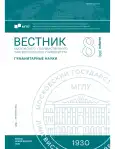Language and Creation in Victoria Welby’s Significs and Semioethics
- Авторлар: Kiose M.I.1,2
-
Мекемелер:
- Moscow State Linguistic University
- Institute of Linguistics RAS
- Шығарылым: № 8(902) (2025)
- Беттер: 69-76
- Бөлім: Linguistics
- URL: https://bakhtiniada.ru/2542-2197/article/view/309472
- ID: 309472
Дәйексөз келтіру
Толық мәтін
Аннотация
The study addresses the problem of ideas transfer in science and the women’s underestimated contribution to this transfer. It identifies the role of language in Victoria Welby’s philosophy of significs and semioethics considering its contribution to the processes of creation. The research data are six Welby’s most influential works published in 1881–1911 which show language as both creator and the created. Conducted within the research framework of spatial semantics, the study reveals the shifts in the agonist and antagonist roles of language as well as the differences in its components distribution attributed to the transformation of Welby’s earlier significs to semioethic views.
Негізгі сөздер
Авторлар туралы
Maria Kiose
Moscow State Linguistic University; Institute of Linguistics RAS
Хат алмасуға жауапты Автор.
Email: maria_kiose@mail.ru
Doctor of Philology (Dr. habil.), Associate Professor, Chief Researcher at Centre for Sociocognitive discourse studies; Leading Researcher at Laboratory of Multichannel communication
РесейӘдебиет тізімі
- Petrilli, S. (2009). Signifying and understanding: reading the works of Victoria Welby and the significs movement. Berlin: De Gruyter.
- Petrilli, S. (2015). Victoria Welby and the science of signs: significs, semiotics, philosophy of language. New Brunswick: Transactions Publishers.
- Petrilli, S. (2023). Significs, pragmatism and mother-sense: Welby’s conversations with Peirce and others. European journal of pragmatism and American philosophy, 15(1), 1–19.
- Radchenko, O. A. (2021). Women in XIXth century linguistics: towards a lithophanic historiography of the language sciences. Vestnik of Moscow State Linguistic University. Humanities, 9(851), 36–47. (In Russ.)
- Germanova, N. N. (2022). Women in the eighteenth-century British linguistics: H.L. Thrale Piozzi and her dictionary of synonyms of the English language. Vestnik of Moscow State Linguistic University. Humanities, 2(857), 74–80. (In Russ.)
- Demyankov, V. Z. (2023). Transfer in the rhetoric of scientific discourse. Cognitive studies of language, 1(52), 27–33. (In Russ.)
- Kiose, M. I. (2018). Faith and reason in the inference theories of V. Welby and Ch.S. Peirce. Logical analysis of language (pp. 535–546). Ed. by N.D. Arutyunova, M.L. Kovshova. Moscow: Gnosis. (In Russ.)
- Iriskhanova, O. K., Kiose, M. I. (2017). On personal transfer of knowledge: phenomenon of epistolary circle of Victoria, lady Welby. Issues of Cognitive Linguistics, 2(51), 26–38. (In Russ.)
- Zykova, I. V. (2016). Formation of language of linvuoculturology: the principles of interdisciplinary transfer of notional framework. Linguistics and semiotics of cultural transfer (pp. 181–202). Ed. by V.V. Feschenko. Moscow: Cultural revolution. (In Russ.)
- Germanova, N. N. (2019). Language and thought in conceptual metaphors of British plilologists of the XVIIIth and XIXth centuries. Cognitive studies of language, 38, 464–471. (In Russ.)
- Johnson, M. (1987). The body in the mind: The bodily basis of meaning, imagination, and reason. Chicago, IL, US: University of Chicago Press.
- Mandler, J. M., Pagán Cánovas, C. (2014). On defining image schemas. Language and Cognition, 6(4), 510–532.
- Mandler, J. M. (1992). The foundations of conceptual thought in infancy. Cognitive Development, 7(3), 273–285.
- Talmy, L. (1988). Force dynamics in language and cognition. Cognitive Science, 2, 49–100.
Қосымша файлдар










